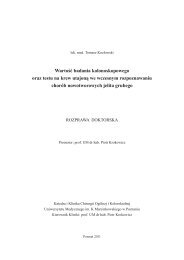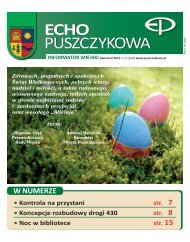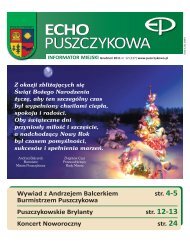MILITARY PHARMACY AND MEDICINE
MILITARY PHARMACY AND MEDICINE
MILITARY PHARMACY AND MEDICINE
You also want an ePaper? Increase the reach of your titles
YUMPU automatically turns print PDFs into web optimized ePapers that Google loves.
© Military Pharmacy and Medicine • 2012 • 4 • 4 – 16most-unsaturated docosahexaenoic acid (DHA).It is this high unsaturation (six double C=Cbonds in the hydrocarbon chain) makes DHAparticularly susceptible to spontaneous peroxidationand fragmentation into cytotoxic compounds,including 4-hydroxy-2-hexenal (HHE)or 4-hydroxy-7-oxyhept-5-enoic acid (HOHA);the latter may additionally form immunogeniccarboxyethylpyrrole-protein (e.g. CEP-albumin)adducts. More details regarding formationof the products of peroxidation of long-chainPUFAs and the properties of carboxyethylpyrrole-proteinadducts are available in other articlesby the same author [2,5].Accumulation of lipofuscin deposits in RPEcells is a manifestation of metabolic inefficacyof their lysosomal compartment, characterizedby reduced autophagy. The reason for thisinefficacy remains unknown, although consideringmolecular complexity of autophagic processes,the reasons may be multiple, includinghypofunction or insufficient quantity/activityof lysosomal enzymes – cathepsins being mostpredominant in normal conditions. Lipofuscindeposits accumulate with age, and the adverseeffect of accumulating oxidative stress thataccompanies lipofuscinogenesis is intensified.Local inflammatory reaction that develops atcertain moment and is manifested by an atypicalprocess referred to as para-inflammation, aswell as drusogenesis (drusens, pseudodrusens),become the driving forces of the developingAMD pathology [4-7, 13].One should not forget that the supply of oxygen(and microelements/nutrients) via the choriocapillarysystem into the photoreceptors-RPE cellscomplex is one of the largest in primates. Takinginto account the functional specificity of theretina, particularly of photoreceptors (photosensitivity,extensive metabolism, high partial pressureof oxygen being the substrate for the formationof oxygen radicals), one may suspect thatretina is particularly well predisposed for formationof reactive oxygen species (ROS) [14].The nature must have predicted the potentiallyadverse, propathogenic processes, such as oxidativestress or lipofuscinogenesis, in the retina, asthe tissue, and particularly the macular region,very important for acute and color vision inprimates, has been equipped with an array ofReview articleantioxidative defense systems, including specificmacular pigments (MPs) – lutein and zeaxanthinand meso-zeaxanthin produced from lutein [15].It should also be mentioned that the classical antioxidativesystems present within the body are classifiedas either enzymatic or non-enzymatic. Enzymaticsystems include three basic enzymes: superoxide dysmutase(SOD), catalase and glutathione peroxidase,which are dependent on metal ions, such as zinc,copper, manganium or selenium. The non-enzymaticsystem consists of carotenoids (including theaforementioned macular pigments), vitamins E andC and glutathione. The enzymatic system is endogenous;however, the metal ions that are required forits proper function are exogenous, i.e. must be suppliedwith food. As far as the non-enzymatic systemis concerned, only glutathione is an endogenous antioxidant.The remaining elements of the system, i.e.carotenoids and vitamins E and C are exogenous factorssupplied with food or appropriate dietary supplements.The role of carotenoids is to neutralize singletoxygen and reactive free radicals. What’s interesting,the mechanisms underlying these two activities ofcarotenoids are different and neutralization of freeradicals may, in certain conditions (e.g. those whenexcessive amounts of radicals are present), changethe antioxidative activity of these compounds intoprooxidative activity.Proper functioning of retinal antioxidationdefense systems is believed to avert potentialearly propathogenic changes that may lead toAMD. These propathogenic changes are in factphysiological reactions that become functionally(chemically) impaired due to their intensityand the accompanying overproduction of reactiveoxygen species (ROS), crucial transformationsof “visual” retinoids and peroxidation andfragmentation of long-chain PUFAs. This may begenerally due to indisposition of the aging body– its organs, tissues and cells, and hypofunctionof the aforementioned antioxidative defense systems,both enzymatic and non-enzymatic. Sincethese systems are dependent on the supply ofexogenous nutrients, thus their activity is dietdependent[2,14–17].A diversified diet, containing vegetables rich incarotenoids, or — more precisely — oxycarotenoidsor xanthophylls (mainly lutein and zeaxanthin;meso-zeaxanthin is not of dietary origin, beingproduced locally from lutein) — should be the4 http://military.isl-journals.com
















